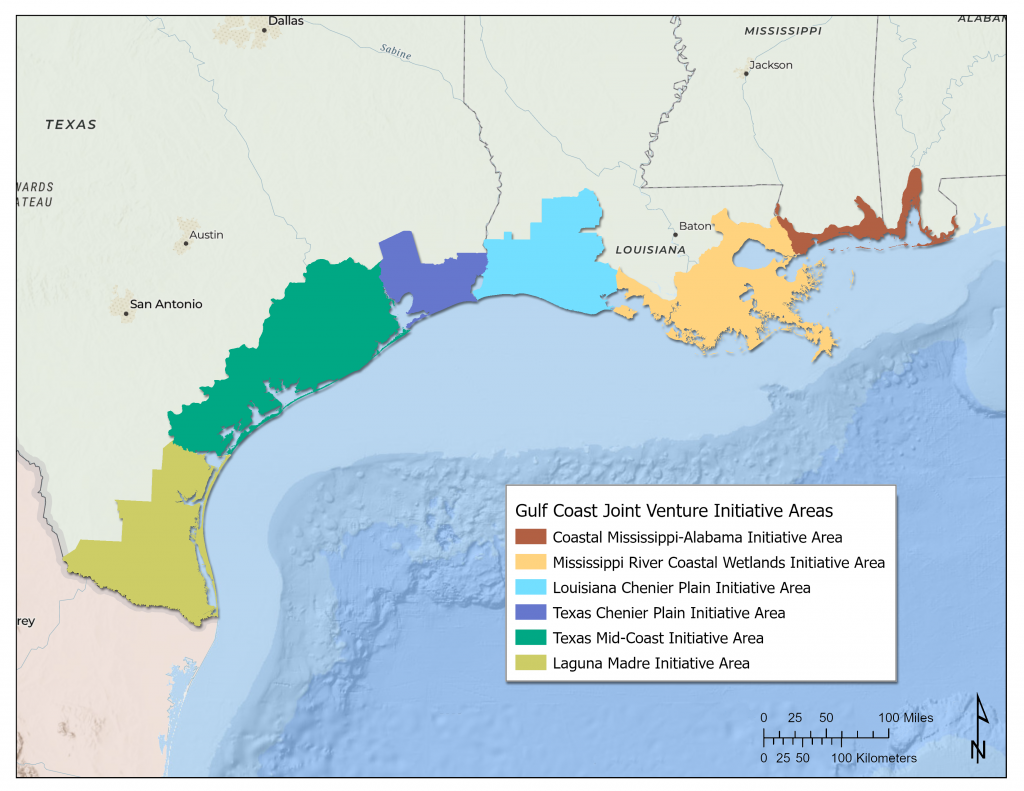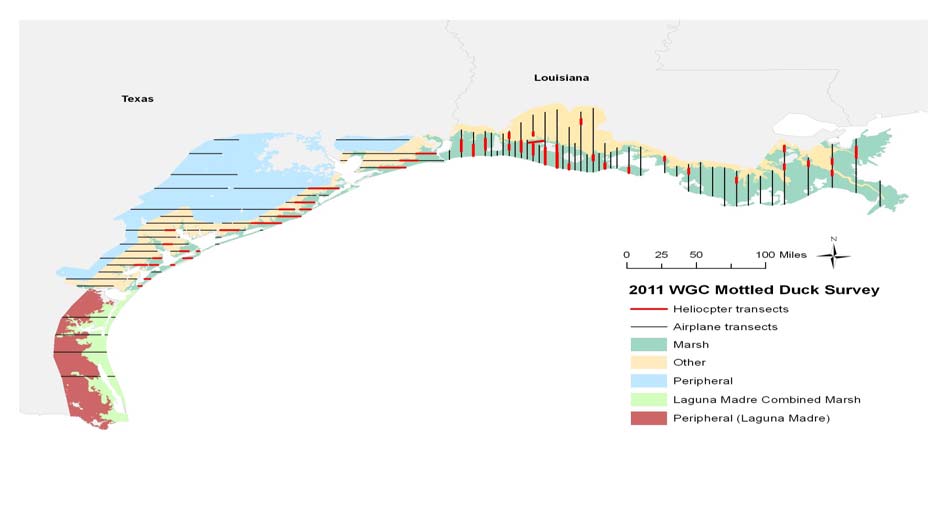By William (Bill) Vermillion and Steve DeMaso
The Mottled Duck (Anas fulvigula) is a year-round resident in Gulf of Mexico coastal marshes and associated habitats. Important breeding habitat requirements include a combination of large blocks (≥ 200 – 400 hectares) (500 – 1000 acres) of fresh-to-intermediate wetlands with inclusions of slightly higher elevation, grass-dominated nesting habitat (Wilson 2007). Hens require non-flooded grassland habitat with relatively low predator densities to successfully bring off broods, which are then led to nearby shallow water wetlands to forage. Appropriate nesting and brood-rearing habitat can also exist in areas with similarly large blocks of rice agriculture, where flooded rice fields are interspersed with fallow grass-dominated fields.
Because of the importance of the region to the species, and because Mottled Duck is an important component of regional waterfowl harvest, it is priority for conservation planning and habitat delivery for the Gulf Coast Joint Venture (GCJV) partnership (Figure 1). Concerns have arisen regarding the status of the species in the GCJV region, where habitat loss and degradation are believed to be limiting suitable nesting and brood-rearing habitat. In 2003, the GCJV formed a Mottled Duck Working Group to provide conservation guidance to the partnership. The Working Group reviewed available population trend data and concluded that the species warranted increased management emphasis to reduce regional declines and stabilize populations, and improved monitoring to enable tracking population trajectories and progress towards population objectives.

Figure 1. Gulf Coast Joint Venture boundary and Initiative Areas
The current GCJV Mottled Duck population objective is based on the average of midwinter waterfowl survey counts from 1971 – 2004. While a valuable dataset, the midwinter survey was never intended to index breeding populations, and its limitations even as a midwinter waterfowl index have been described by Eggeman and Johnson (1989) and Sharp et al. (2002). To supplement the midwinter waterfowl survey data, the Texas Parks and Wildlife Department (TPWD), the Louisiana Department of Wildlife and Fisheries (LDWF), the U.S. Fish and Wildlife Service, Division of Migratory Bird Monitoring (USFWS, DMBM) and GCJV staff jointly developed the Western Gulf Coast (WGC) Mottled Duck Breeding Population Survey to estimate the breeding season population of Mottled Ducks in Louisiana and Texas. The survey’s primary objectives are to provide an annual estimate of the breeding Mottled Duck population along the western Gulf Coast, determine the population trend over time, and to provide a standardized protocol for estimating Mottled Duck abundance in Texas and Louisiana.
Initiated in 2008, the WGC Mottled Duck Breeding Population Survey is a visibility-corrected aerial survey covering the Texas and Louisiana coastal zones (Figure 2). The survey is conducted annually by TPWD and LDWF staff in their respective states during the second week of April, which is approximately the middle of the nesting period for the species in the western Gulf Coast. A series of transects, running east to west in Texas, and north to south in Louisiana, are flown in airplanes at an approximate altitude of 30 – 50 meters (m) (98 – 170 feet) at a speed of approximately 161 kilometers per hour (100 miles per hour). Two observers, one to the front right seat adjacent to the pilot, and another seated behind the pilot, record all Mottled Ducks seen within 200 m (~656 feet) of the plane. A subset of transect segments, all within Mottled Duck high density areas, are re-flown with helicopters on the day after airplane surveys. Helicopters fly at low (<30 m; <100 feet) altitudes in tight curves over the transect line to flush ducks. Observers on each side of the helicopter record all Mottled Ducks within a 400 m (~1,300 foot) transect strip. These helicopter observations are used to calculate a visibility-correction factor to account for birds undetected during the airplane surveys (K. Fleming and M. Otto, USFWS, unpublished report).

Figure 2. Locations of survey transects for the Western Gulf Coast Mottled Duck Breeding Population Survey (K. Fleming, USFWS, unpublished report)
Transects in both states are allocated across marsh and “other” habitats, with other habitats largely dominated by agriculture or aquaculture. In Texas, some transects extend into “peripheral” habitats, so designated due to perceived lower densities of Mottled Ducks compared with “core” habitats (Figure 2). Because of substantial density differences between marsh and other core and peripheral habitats, separate calculations are used to estimate overall densities for each. Bird densities, visibility correction factors and overall population estimates are calculated following Smith (1995).
Survey data are compiled and analyzed by the USFWS, DMBM, Population and Habitat Assessment Branch and delivered in an annual report to stakeholders. Additionally, these data and associated measures of variance, along with tables and graphs comparing results to GCJV population objectives, are compiled in a chronological database, by state, and pooled, by the GCJV Monitoring Coordinator, and are available upon request.
Truly an emblematic Gulf of Mexico avian species, the future of the Mottled Duck is tied to the future of the Gulf’s emergent marshes and adjacent grasslands. Coastal wetland and grassland restoration is a priority along the western Gulf Coast, and management for Mottled Ducks is a priority on that region’s state, federal, and privately-owned coastal wetlands and grasslands. The WGC Mottled Duck Breeding Population Survey provides a method to assess trends and abundance of the species more effectively and may be a valuable monitoring tool to measure the success of coastal habitat restoration and waterfowl management techniques.
References
Eggeman, D.R., and F.A. Johnson. Variation in effort and methodology for the mid-winter waterfowl inventory in the Atlantic flyway. Wildlife Society Bulletin 17(3):227-233.
Sharp, D.E., K.L. Kruse, and P.P. Thorpe. 2002. The midwinter waterfowl survey in the central flyway. USFWS, Division of Migratory Bird Management, Denver, CO.
Smith, G.W. 1995. A critical review of the aerial and ground surveys of breeding waterfowl in North America. U.S. Department of Interior Biological Science Report 5, Washington, D.C.
Wilson, B.C. 2007. North American Waterfowl Management Plan, Gulf Coast Joint Venture: Mottled Duck conservation plan. North American Waterfowl Management Plan, Albuquerque, NM.
